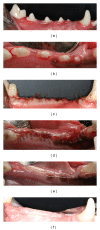In vivo assessment of osseous wound healing using a novel bone putty containing lidocaine in the surgical management of tooth extractions
- PMID: 22754572
- PMCID: PMC3382256
- DOI: 10.1155/2012/894815
In vivo assessment of osseous wound healing using a novel bone putty containing lidocaine in the surgical management of tooth extractions
Abstract
Objective. This preclinical pilot study evaluated the systemic, radiographic, and histological responses to bone putty containing lidocaine in a canine tooth extraction model. Methods. In five beagle dogs the right mandibular premolars were extracted and sockets grafted with (1) xenograft particulate bone and a collagen sponge plug (control), (2) bone putty alone, (3) bone putty mixed with xenograft (3 : 1), or (4) xenograft sandwiched between bone putty. At 6 weeks post-op, the systemic and local responses were evaluated using a blood chemistry panel, micro-CT, and histological analyses. Results. No significant differences in blood chemistries were noted at 6 weeks postgrafting compared to baseline. Sockets grafted with either bone putty formulation demonstrated comparable radiographic and histologic evidence of bone healing compared to control sockets. Conclusions. Our preclinical results indicate that this bone putty appears to be a safe biocompatible device that may be useful in the postoperative management of tooth extractions.
Figures





Similar articles
-
Alveolar ridge preservation with the socket-plug technique utilizing an alloplastic putty bone substitute or a particulate xenograft: a histological pilot study.J Oral Implantol. 2015 Apr;41(2):178-83. doi: 10.1563/AAID-JOI-D-13-00025. Epub 2013 Jun 17. J Oral Implantol. 2015. PMID: 23772806
-
Early inhibitory effects of zoledronic acid in tooth extraction sockets in dogs are negated by recombinant human bone morphogenetic protein.J Oral Maxillofac Surg. 2014 Jan;72(1):61-6. doi: 10.1016/j.joms.2013.06.192. Epub 2013 Jul 25. J Oral Maxillofac Surg. 2014. PMID: 23891015
-
Radiographic and histologic observations of sequential healing processes following ridge augmentation after tooth extraction in buccal-bone-deficient extraction sockets in beagle dogs.J Clin Periodontol. 2018 Nov;45(11):1388-1397. doi: 10.1111/jcpe.13014. Epub 2018 Oct 23. J Clin Periodontol. 2018. PMID: 30246359
-
A new procedure for processing extracted teeth for immediate grafting in post-extraction sockets. An experimental study in American Fox Hound dogs.Ann Anat. 2018 May;217:14-23. doi: 10.1016/j.aanat.2017.12.010. Epub 2018 Feb 15. Ann Anat. 2018. PMID: 29454891
-
Effects of a putty-form hydroxyapatite matrix combined with the synthetic cell-binding peptide P-15 on alveolar ridge preservation.J Periodontol. 2008 Feb;79(2):291-9. doi: 10.1902/jop.2008.070038. J Periodontol. 2008. PMID: 18251643 Clinical Trial.
Cited by
-
Preparation and characterization of PEG-PPG-PEG copolymer/pregelatinized starch blends for use as resorbable bone hemostatic wax.J Mater Sci Mater Med. 2013 Dec;24(12):2881-8. doi: 10.1007/s10856-013-5027-x. Epub 2013 Aug 17. J Mater Sci Mater Med. 2013. PMID: 23955721
-
From micro- to nanostructured implantable device for local anesthetic delivery.Int J Nanomedicine. 2016 Jun 8;11:2695-709. doi: 10.2147/IJN.S99028. eCollection 2016. Int J Nanomedicine. 2016. PMID: 27354799 Free PMC article. Review.
-
In vivo assessment of new resorbable PEG-PPG-PEG copolymer/starch bone wax in bone healing and tissue reaction of bone defect in rabbit model.J Mater Sci Mater Med. 2014 Sep;25(9):2131-9. doi: 10.1007/s10856-014-5249-6. Epub 2014 Jun 10. J Mater Sci Mater Med. 2014. PMID: 24913421
References
-
- Malamed SF. Local anesthetics: dentistry’s most important drugs, clinical update 2006. Journal of the California Dental Association. 2006;34(12):971–976. - PubMed
-
- Bouloux GF, Steed MB, Perciaccante VJ. Complications of third molar surgery. Oral and Maxillofacial Surgery Clinics of North America. 2007;19(1):117–128. - PubMed
-
- Scully C. Medical Problems in Dentistry. London, UK: Churchill Livingstone Elsevier; 2010. Haematology; pp. 177–233.
-
- Seymour AR, Meechan JG, Yates SM. Pharmacology and Dental Therapeutics. New York, NY, USA: Oxford University Press; 1999. Aspirin, other non-steroidal anti-inflammatory drugs, and paracetamol; pp. 89–94.
-
- Fischer LM, Schlienger RG, Matter CM, Jick H, Meier CR. Discontinuation of nonsteroidal anti-inflammatory drug therapy and risk of acute myocardial infarction. Archives of Internal Medicine. 2004;164(22):2472–2476. - PubMed
LinkOut - more resources
Full Text Sources
Miscellaneous

